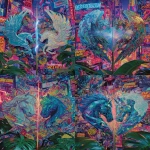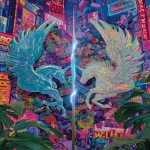Explore the Best AI Image Gallery

Beyond the Canvas: How VR and AR are Transforming Gaming and Creativity
The landscape of gaming is undergoing a seismic shift, propelled by the emergence of immersive technologies like virtual reality (VR) and augmented reality (AR). These groundbreaking innovations are not only redefining how we play games but also profoundly impacting the creative industry, offering exciting possibilities for artists, designers, and developers alike.
A New Realm of Creative Expression
VR and AR provide game developers with unparalleled tools to craft immersive experiences that blur the lines between the digital and physical worlds. Imagine stepping into a virtual world where you can interact with characters, explore fantastical landscapes, and participate in adventures like never before. This level of immersion allows for unprecedented creative freedom, enabling developers to build games that are not just visually stunning but also deeply engaging on an emotional and intellectual level.
Beyond traditional game design, VR and AR are opening doors to new forms of artistic expression. Artists can now create interactive installations, immersive performances, and virtual sculptures that respond to user input, blurring the boundaries between art and technology. Imagine attending a concert in a virtual space where you can interact with the music and visuals, or exploring a museum exhibit that comes alive through augmented reality overlays.
Applications Beyond Gaming
The impact of VR and AR extends far beyond the realm of gaming. These technologies are finding applications in diverse fields, revolutionizing industries such as education, healthcare, and architecture:
- Education: Immersive VR experiences can transport students to historical sites, explore the human body from the inside out, or even conduct virtual science experiments. This hands-on approach fosters deeper understanding and engagement.
- Healthcare: Surgeons can practice complex procedures in a risk-free virtual environment, patients can undergo pain management through VR distraction techniques, and therapists can utilize AR tools to provide interactive rehabilitation exercises.
- Architecture: Architects and clients can visualize building designs in 3D, walk through virtual spaces before construction begins, and identify potential design flaws early on, streamlining the design process.
Ethical Considerations: Navigating Uncharted Territory
As with any powerful technology, VR and AR raise important ethical considerations that require careful attention:
- Privacy and Data Security: VR and AR systems collect vast amounts of user data. It is crucial to establish robust privacy protocols and ensure user consent for data collection and usage.
- Accessibility and Inclusivity: Technology should be accessible to all, regardless of physical or cognitive abilities. Developers need to consider the needs of diverse users when designing VR and AR experiences.
- Bias and Representation: VR and AR environments can perpetuate existing biases if not carefully designed. It is essential to ensure diverse representation in virtual worlds and address potential harmful stereotypes.
Future Trends: The Evolution of Immersive Experiences
The field of VR and AR is constantly evolving, with exciting advancements on the horizon:
- Enhanced Realism: Advances in graphics processing and haptic feedback will create even more realistic and immersive experiences.
- Brain-Computer Interfaces: Direct brain-computer interfaces could allow for seamless control of virtual environments, blurring the lines between thought and action.
- Social VR: Virtual worlds will become increasingly social, enabling people to connect, collaborate, and share experiences in immersive environments.
VR and AR are poised to revolutionize the creative industry, ushering in a new era of artistic expression, innovation, and collaboration. By embracing these transformative technologies responsibly, we can unlock their full potential to shape the future of entertainment, education, and human connection.




](https://images.ai-img.art/thumbnails/150/373119af50bb2bbfb50a8cdc8553ce406f53ca4cb5768634dc4829a74f518099.webp)

](https://images.ai-img.art/thumbnails/150/653a399f3dad2365351e1bc05bd0ccfd971813d543790c0a02d14aad7607acf7.webp)






](https://images.ai-img.art/thumbnails/150/87223bcd1dd489967e049024077e69c59a8d0a7d856a01b269f39543e01743b0.webp)



](https://images.ai-img.art/thumbnails/150/84413140dfbf73432940633887d0996571932a82c7b12f7f419b5ad29bd451d3.webp)





](https://images.ai-img.art/thumbnails/150/237a4fb11ca3d9f5be206e8e30cdacfd75812c7759119ed538b34fe6182abbed.webp)













](https://images.ai-img.art/thumbnails/150/e7ac2b994cbd3f5844034baa2b1c62944b79a018d48a3b8bf06cb33f39c3fbbc.webp)



](https://images.ai-img.art/thumbnails/150/d9da31863471e24e22e6987ea60c8dca3b3116fe9a2769316442fca4e0d14825.webp)
](https://images.ai-img.art/thumbnails/150/6ab3cb7e5b139d753829753b763176e20426c8c682186b969c401f63e1244c8e.webp)






](https://images.ai-img.art/thumbnails/150/f971ca6f483297e9a02f45e3e32f25bd38fe56db23a5028d2c9f83e8d8722fce.webp)